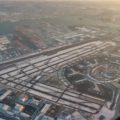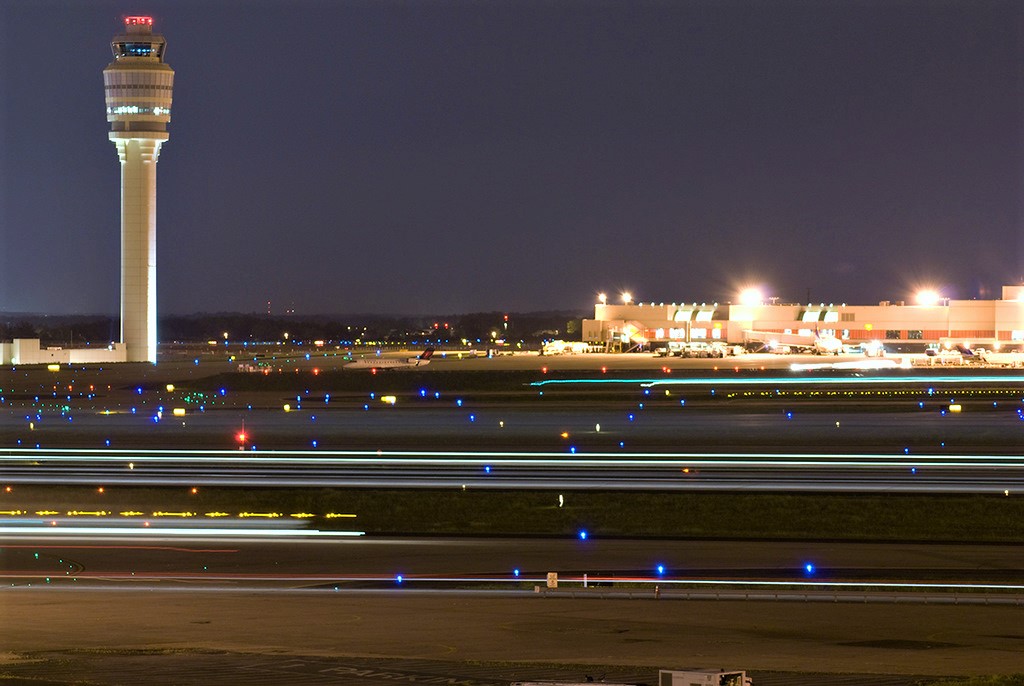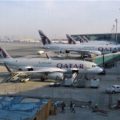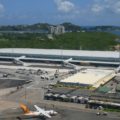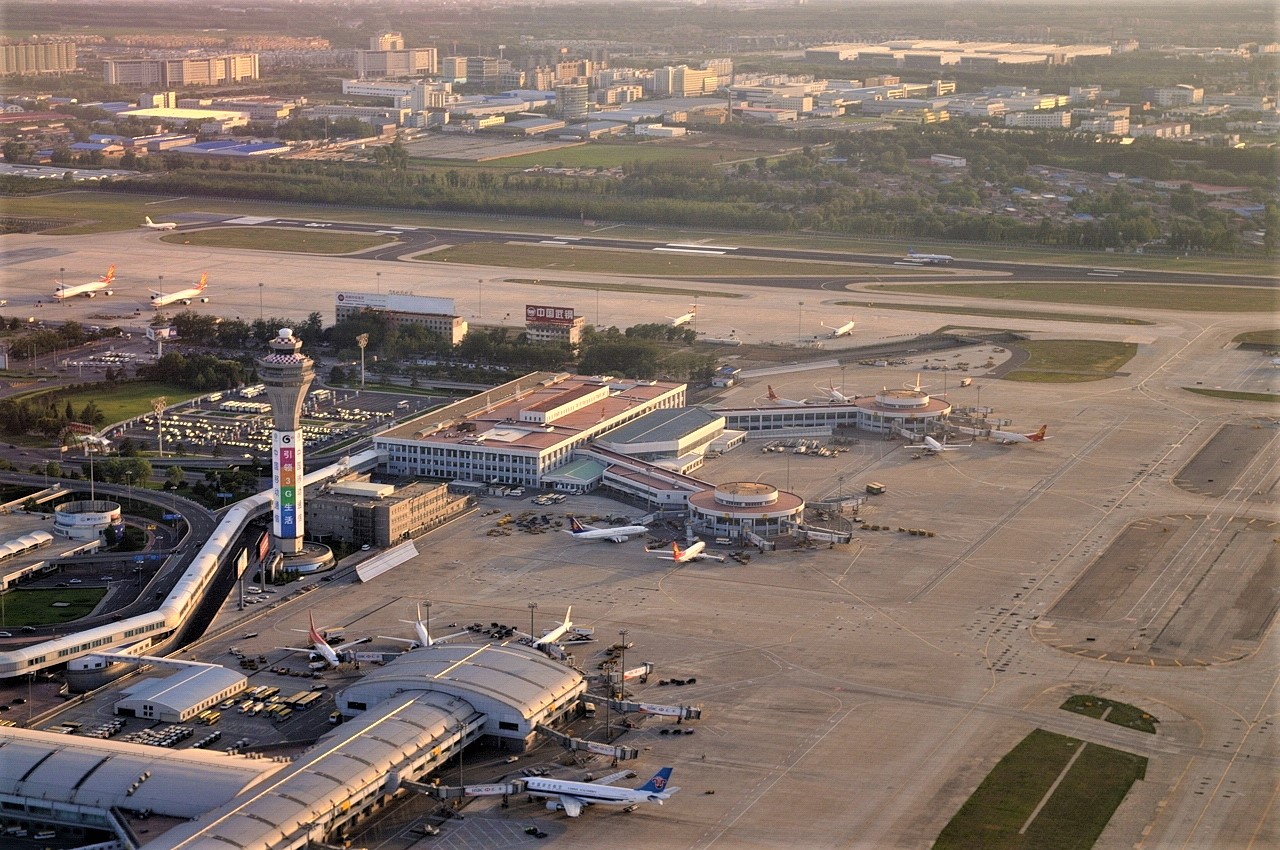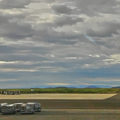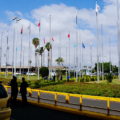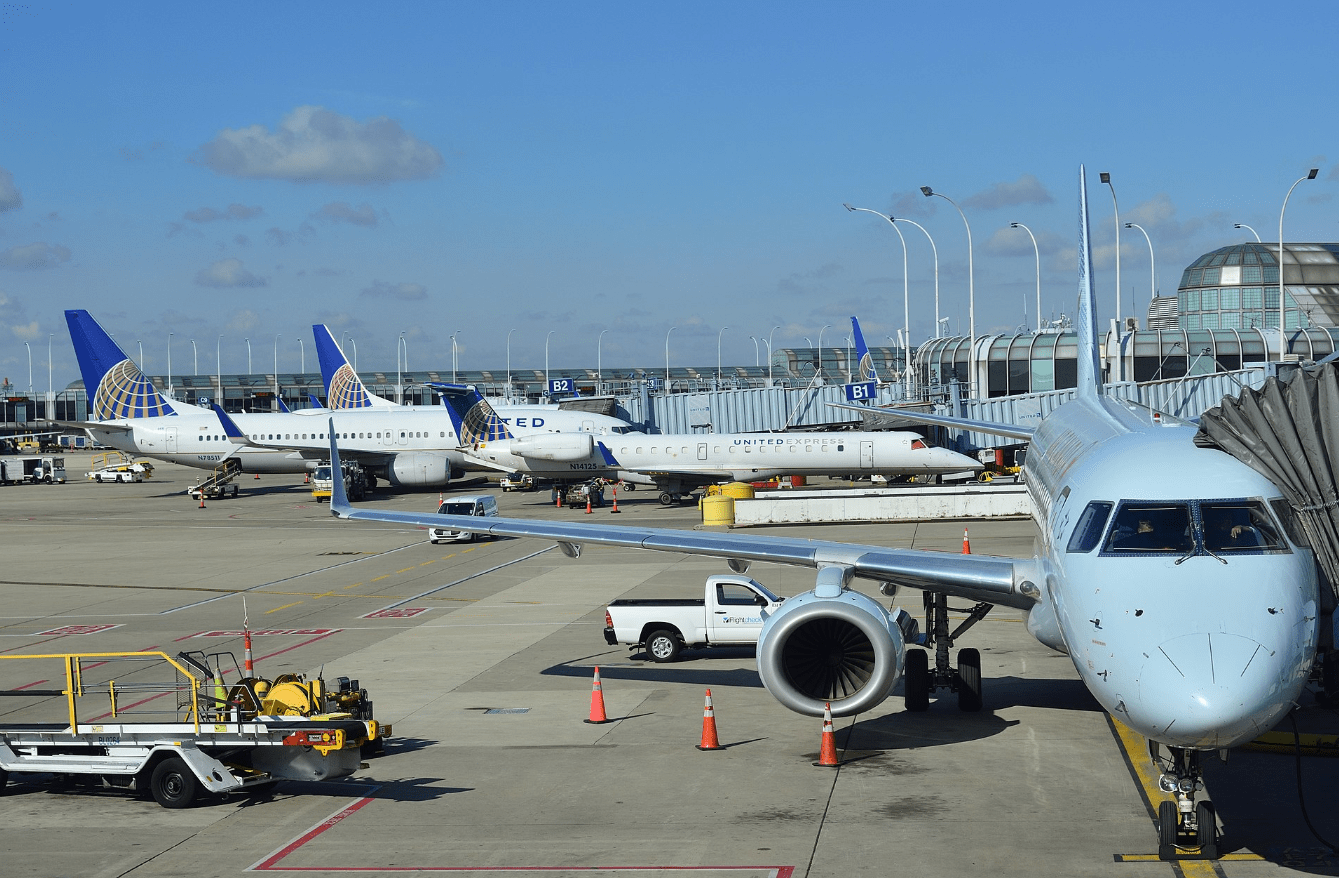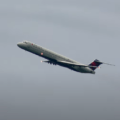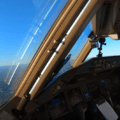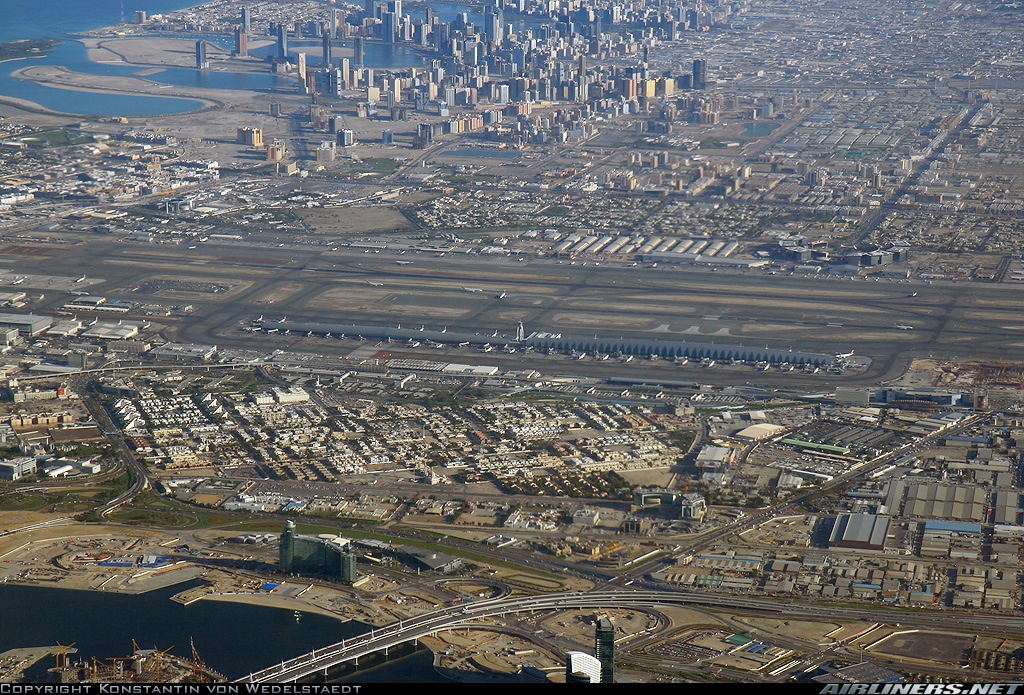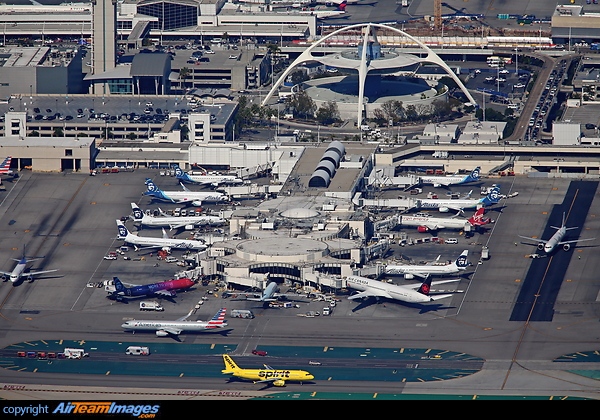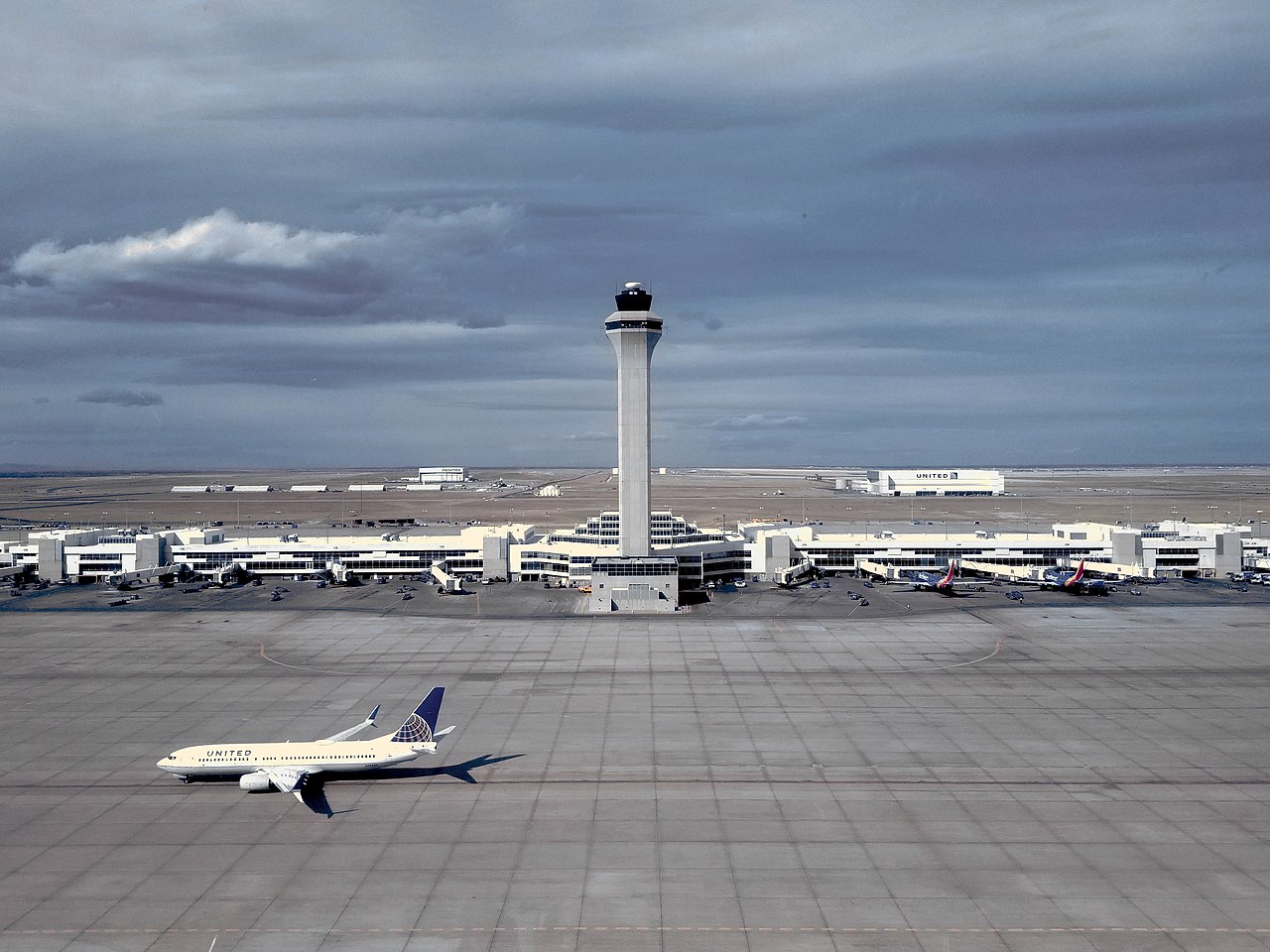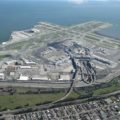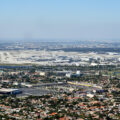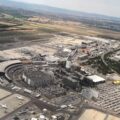Aviation
Washington Dulles International Airport
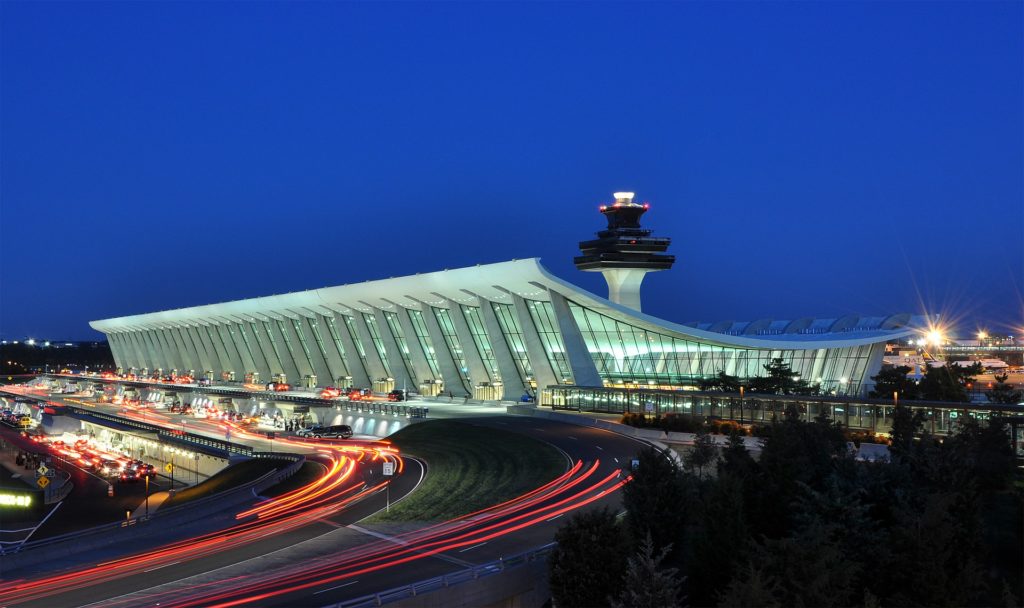
Source: Joe Ravi (Shutterstock iStock Dreamstime
| IATA: IAD ICAO: KIAD FAA LID: IAD WMO: 72403 | |
| Airport type | Public |
| Owner/Operator | Metropolitan Washington Airports Authority |
| Serves | Washington metropolitan area |
| Location | Dulles, Virginia, U.S. |
| Opened | November 17, 1962 |
| Hub for | United Airlines |
| Elevation AMSL | 313 ft / 95 m |
| Coordinates | |
| Website | flydulles.com |
Washington Dulles International Airport (IATA: IAD, ICAO: KIAD, FAA LID: IAD), typically referred to as Dulles International Airport, Dulles Airport, Washington Dulles or simply Dulles (/ˈdʌlɪs/ DUL-iss), is an international airport in the Eastern United States, located in Loudoun County and Fairfax County in Virginia, 26 miles (42 km) west of Downtown Washington, D.C.
Opened in 1962, it is named after John Foster Dulles (1888–1959), the 52nd U.S. Secretary of State who served under President Dwight D. Eisenhower. The Dulles main terminal is a well-known landmark designed by Eero Saarinen. Operated by the Metropolitan Washington Airports Authority, Washington Dulles Airport occupies 13,000 acres (20.3 sq mi; 52.6 km2) straddling the Loudoun–Fairfax line. Most of the airport is in the unincorporated community of Dulles in Loudoun County, with a small portion in the unincorporated community of Chantilly in Fairfax County. The airport is one of two that serves the Washington metropolitan area.
Dulles is one of the three major airports in the larger Baltimore–Washington metropolitan area with more than 24 million passengers a year. Dulles has the most international passenger traffic of any airport in the Mid-Atlantic outside the New York metropolitan area, including approximately 90% of the international passenger traffic in the Baltimore–Washington region. On a typical day, more than 60,000 passengers pass through Dulles to and from more than 125 destinations around the world. In 2018, Dulles Airport surpassed Ronald Reagan Washington National Airport (DCA) in yearly passenger boardings after having fewer passengers since 2015. However, it still ranks behind Baltimore–Washington International Thurgood Marshall Airport (BWI) in total annual passenger boardings. Dulles is a hub for United Airlines.
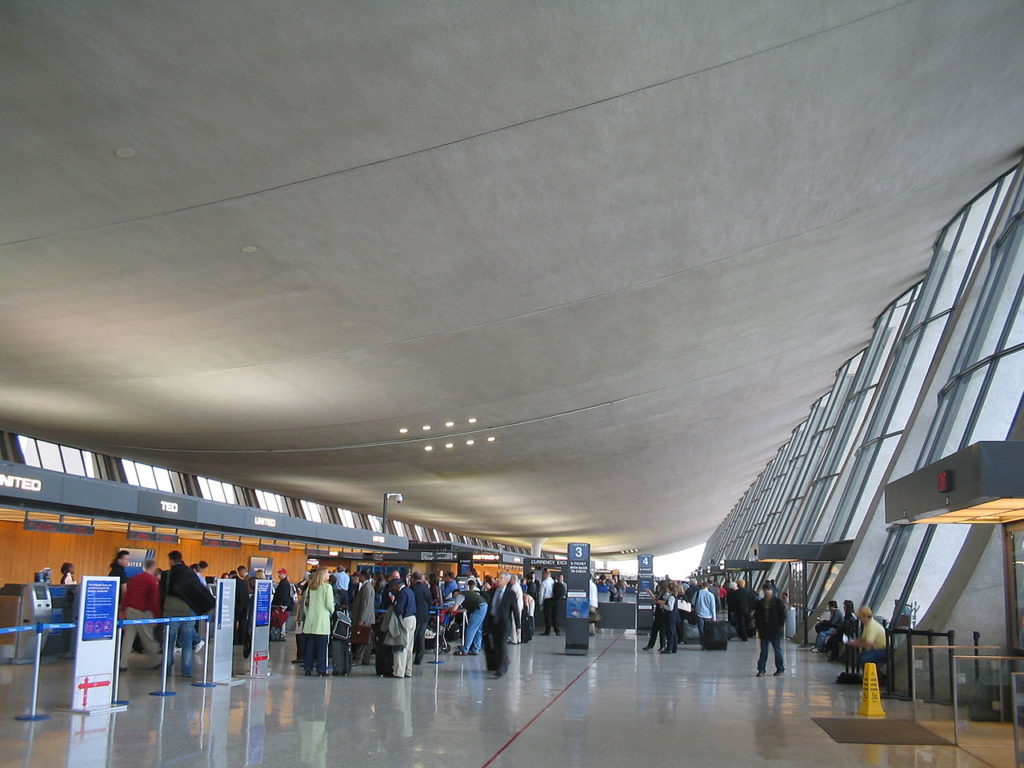

Source: David Benbennick
Terminals


Source: CZmarlin — Christopher Ziemnowicz
The airport’s terminal complex consists of a main terminal (which includes four of the original gates, “Z” gates), and two parallel midfield terminal buildings: Concourses A/B and C/D. The entire terminal complex has 123 gates and 16 hardstand locations from which passengers can board or disembark using the airport’s plane mate vehicles
Inter-terminal transportation
Conceived in early planning sessions in 1959, Dulles is one of the few remaining airports to use the mobile lounge (also known as “plane mates” or “people movers”) now only used for transport to the International Arrivals Building as well as transport for Concourse D. They have all been given names based on the postal abbreviations of 50 states, e.g., VA, MD, AK.
The Metropolitan Washington Airports Authority has gradually phased out the mobile lounge system for inter-terminal passenger movements in favor of the AeroTrain, an underground people mover which currently operates to all of the concourses except concourse D, with passenger tunnels remaining to concourses A and B. Plane mates remain in use to disembark international passengers and carry them to the International Arrivals Building, as well as to transport passengers to and from aircraft on the hard stands (i.e., those parked remotely on the apron without access to jet bridges).
Main terminal
Dulles’s iconic main terminal houses ticketing on the upper level, baggage claim and U.S. Customs and Border Protection on the lower level, and annexes for the International Arrivals Building for international passenger processing, as well as the Z gates (used by Air Canada, Frontier and United Express), various information kiosks and other support facilities. The main terminal was recognized by the American Institute of Architects in 1966 for its design concept; its roof is a suspended catenary providing a wide enclosed area unimpeded by any columns.
The main terminal was extended in 1996 to 1,240 feet (380 m)—Saarinen’s original design length—which was slightly more than double its originally constructed length of 600 feet (180 m). On September 22, 2009, an expansion to include the 41,400 square feet (3,850 m2) International Arrivals Building opened for customs and immigration processing with a capacity to process 2,400 passengers per hour


Source: Acroterion
Midfield terminals
All airlines aside from Air Canada Express, Frontier Airlines, and United Express operate out of two linear satellite terminals which are Concourses A and B, and Concourses C and D.
Concourses A and B
All non-United flights operate out of these two concourses as well as some United Express flights. Concourse A (which has 47 gates) composes the eastern part of the closest midfield terminal building. It consists of a permanent ground level set of gates designed for small planes and regional jets used by United Express, and several former Concourse B gates. The concourse is primarily used for international flights. Air France operates an airline lounge opposite gate A22, Etihad Airways operates a First and Business Class lounge across from gate A15, and Virgin Atlantic has a Clubhouse lounge across from gate A32. Concourse A’s AeroTrain station is located about halfway through the concourse, between gates A6 and A14.
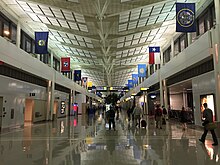

Source: Famartin
Concourse B (which has 28 gates) composes the western half of the building. It is the first of the permanent elevated midfield concourses. Originally constructed in 1998 and designed by Skidmore, Owings & Merrill and Hellmuth, Obata and Kassabaum, the B concourse contained 20 gates. In 2003, 4 additional gates were added to concourse B, followed by a 15-gate expansion in 2008.] In addition to the AeroTrain station located between gates B51 and B62, Concourse B also has an underground walkway to connect it to the main terminal. Concourse B is used by some international carriers, and is also utilized by all non-United domestic and Canada flights. The facility also includes a British Airways Galleries lounge, a Lufthansa lounge divided into Senator and Business class sections located between gates B49 and B51, and a Turkish Airlines Lounge near gate B43.
Concourses C and D
Concourses C/D are solely used for United Airlines flights, as it functions as their hub at IAD. All mainline United flights and most United Express regional jet operations operate out of these concourses (some United Express flights use Concourse A).
These concourses were constructed in 1983 and designed by Hellmuth, Obata and Kassabaum. The two concourses have 22 gates each, numbered C1–C28 and D1–D32, with odd-numbered gates on the north side of the building and even numbered gates on the south side. Concourse C composes the eastern half of the terminal and Concourse D composes the gates on the west half of the terminal. The C/D concourses were given a face lift in 2006 which included light fixture upgrades, new paint finishes, new ceiling grids and tiles, heating and air conditioning replacement, and complete restroom renovations.
Concourse C also has a dedicated Federal Inspection Station located at ground level. International United flights not originating at an airport with US customs pre-clearance can directly deplane passengers via the jet bridge at Concourse C (as opposed to using plane mates to offload passengers). Once deplaned, arriving passengers are separated. Passengers terminating at Dulles take a mobile lounge that transports them to the International Arrivals Building, while connecting passengers continuing on another United flight go through U.S. Customs and Immigration at the FIS station on the ground level. Since this immigration facility is only for connecting passengers on United and other Star Alliance carriers, it has shorter lines and passengers don’t have to re-clear security at the massive security checkpoints in the main terminal.
A new and permanent C/D concourse (also called “Tier 2”) is planned as part of the D2 Dulles Development Project. The new building is to include a three-level structure with 44 airline gates and similar amenities to Concourse B. The concourse plan includes a dedicated mezzanine corridor with moving sidewalks to serve international passengers. The design and construction of the new C/D concourse has not been scheduled.[63] When built, it is planned that both terminals will be connected to the main terminal and other concourses via the AeroTrain. To that extent, the AeroTrain station at Concourse C was built at the location where the future Concourse C/D structure is proposed to be built, and is connected to the existing Concourse C via an underground walkway.
Airline lounges


through a skylight in the main terminal
Source: Antony-22
Air traffic control tower viewed through a skylight in the main terminal
Since many major domestic and international airlines have a large presence at Washington Dulles, there are numerous airline lounges within the airport:
- Air France: Air France/KLM Lounge, A Concourse across from gate A22.
- British Airways: BA Lounge with Concorde Dining for first class passengers.
- Etihad Airways: First and Business class lounge located opposite gate A15.
- Lufthansa: Senator Lounge and Business Lounge, B Concourse at gate B51.
- Turkish Airlines: Concourse B, near gate B41.
- United Airlines: United Clubs in C Concourse (at gates C4 [the former Global First Class Lounge], C7 and C17), and one in D Concourse at gate D8. As of June 2019, United has begun construction on their latest Polaris Lounge, located across from gate C17 next to the AeroTrain escalator, due to open early 2020.
- Virgin Atlantic: Clubhouse, A Concourse across from gate A32.
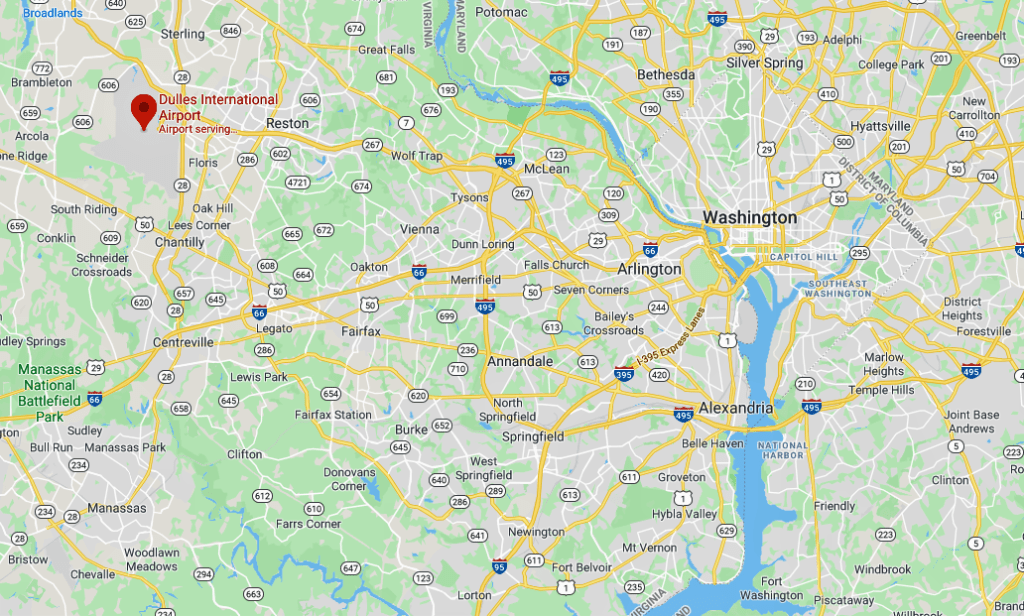

Airlines and destinations
Passenger
| Airlines | Destinations | |
|---|---|---|
| Aer Lingus | Dublin | |
| Aeroflot | Moscow–Sheremetyevo | |
| Air Canada Express | Montréal–Trudeau, Toronto–Pearson | |
| Air China | Beijing–Capital | |
| Air France | Paris–Charles de Gaulle | |
| Air India | Delhi | |
| Alaska Airlines | Los Angeles, San Francisco, Seattle/Tacoma | |
| Alitalia | Rome–Fiumicino | |
| All Nippon Airways | Tokyo–Haneda | |
| American Airlines | Charlotte, Dallas/Fort Worth, Los Angeles | |
| American Eagle | Charlotte | |
| Austrian Airlines | Vienna | |
| Aviancaa | Bogotá, La Paz | |
| Avianca El Salvador | San Salvador | |
| British Airways | London–Heathrow | |
| Brussels Airlines | Brussels | |
| Cabo Verde Airlines | Sal | |
| Cathay Pacific | Hong Kong | |
| Copa Airlines | Panama City | |
| Delta Air Lines | Atlanta, Minneapolis/St. Paul, Salt Lake City, Seattle/Tacoma | |
| Delta Connection | Detroit, Minneapolis/St. Paul, New York–JFK | |
| EgyptAir | Cairo | |
| Emirates | Dubai–International | |
| Ethiopian Airlinesb | Addis Ababa | |
| Etihad Airways | Abu Dhabi | |
| Frontier Airlines | Austin, Denver, Las Vegas, Orlando Seasonal: San Antonio | |
| Iberia | Madrid | |
| Icelandair | Reykjavík–Keflavík | |
| KLM | Amsterdam | |
| Korean Air | Seoul–Incheon | |
| LOT Polish Airlines | Warsaw–Chopin (begins June 2, 2020) | |
| Lufthansa | Frankfurt, Munich | |
| Porter Airlines | Toronto–Billy Bishop | |
| Qatar Airways | Doha | |
| Royal Air Maroc | Casablanca | |
| Saudia | Jeddah, Riyadh Hajj: Medina | |
| Scandinavian Airlines | Copenhagen | |
| South African Airwaysc | Accra, Johannesburg–O. R. Tambo | |
| Southwest Airlines | Atlanta, Denver, Orlando | |
| Sun Country Airlines | Seasonal: Minneapolis/St. Paul | |
| TAP Air Portugal | Lisbon | |
| Turkish Airlines | Istanbul | |
| United Airlines | Amsterdam, Atlanta, Austin, Beijing–Capital, Boston, Brussels (resumes July 6, 2020), Cancún, Chicago–O’Hare, Cleveland, Columbus–Glenn, Dallas/Fort Worth, Denver, Fort Lauderdale, Fort Myers, Frankfurt, Geneva, Hartford, Honolulu, Houston–Intercontinental, Kansas City, Las Vegas, London–Heathrow (resumes July 6, 2020), Los Angeles, Mexico City, Munich (resumes July 6, 2020), Nashville, Newark, New Orleans, Orlando, Paris–Charles de Gaulle, Phoenix–Sky Harbor, Portland (OR), Raleigh/Durham, Sacramento, San Antonio, San Diego, San Francisco, San Juan, São Paulo–Guarulhos, Seattle/Tacoma, Tampa, Tel Aviv, Tokyo–Haneda, Zurich (resumes July 6, 2020), Seasonal: Aruba, Barcelona, Charleston (SC), Dublin, Edinburgh, Grand Cayman, Guatemala City, Hayden/Steamboat Springs, Indianapolis, Lisbon, Madrid, Miami, Montego Bay, Norfolk, Providenciales, Punta Cana, Rome–Fiumicino, St. Maarten, St. Thomas, San José de Costa Rica, San José del Cabo, Vancouver | |
| United Express | Akron/Canton (begins June 18, 2020), Albany, Asheville, Atlanta, Austin, Bangor (begins July 6, 2020), Boston, Buffalo, Burlington (VT), Charleston (SC), Charlotte, Charlottesville (VA), Clarksburg (WV), Chicago–O’Hare, Cincinnati, Cleveland, Columbia (SC), Columbus–Glenn, Dallas/Fort Worth, Dayton, Detroit, Grand Rapids, Greensboro, Greenville/Spartanburg, Harrisburg, Hartford, Houston–Intercontinental, Huntsville, Indianapolis, Ithaca, Jacksonville, Kansas City, Knoxville, Lewisburg (WV), Lexington (KY), Louisville, Madison (begins July 6, 2020), Manchester (NH), Minneapolis/St. Paul, Montréal–Trudeau, Nashville, Newark, New Orleans, New York–LaGuardia, Norfolk, Ogdensburg, Oklahoma City, Ottawa, Philadelphia, Pittsburgh, Plattsburgh, Portland (ME), Providence, Raleigh/Durham, Richmond, Roanoke, Rochester (NY), St. Louis, San Antonio, Sarasota, Savannah, Shenandoah Valley, State College (PA), Syracuse, Toronto–Pearson, West Palm Beach, Wilkes-Barre/Scranton, Wilmington (NC) Seasonal: Hilton Head, Nassau, Traverse City | |
| Virgin Atlantic | London–Heathrow | |
| Volaris Costa Rica | San José de Costa Rica, San Salvador |
Notes
Cargo
| Airlines | Destinations |
|---|---|
| FedEx Express | Harrisburg, Indianapolis, Memphis, New York–JFK, Newark, Philadelphia |
| FedEx Feeder | Newark |
| UPS Airlines | Louisville |
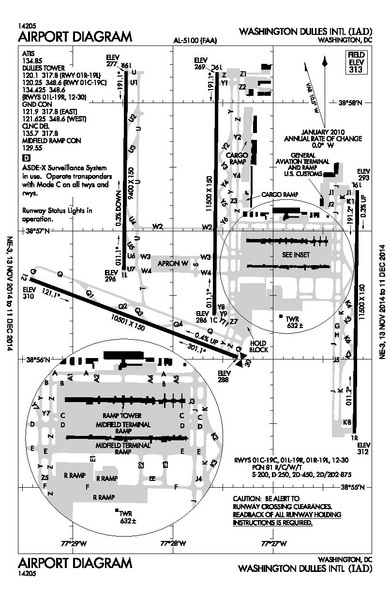

Ground transportation
Roads
Washington Dulles is accessible via the Dulles Access Road/Dulles Greenway (State Route 267) and State Route 28. The Dulles Airport Access Highway is a toll-free, limited access highway owned by the Metropolitan Washington Airports Authority (MWAA) to facilitate car access to Washington Dulles from the Capital Beltway and Interstate 66. After it opened, non-airport traffic between Washington and Reston became so heavy that a parallel set of toll lanes were added on the same right-of-way to accommodate non-airport traffic (Dulles Toll Road). However, the airport-only lanes are both less congested as well as toll-free. As of November 1, 2008, MWAA assumed responsibility from the Virginia Department of Transportation both for operating the Dulles Toll Road and for the construction of a rapid transit rail line down its median. Route 28, which runs north–south along the eastern edge of the airport, has been upgraded to a limited access highway, with the interchanges financed through a property tax surcharge on nearby business properties. The Dulles Toll Road has been extended to the west to Leesburg as the Dulles Greenway.
Public transportation
Fairfax Connector bus routes 981 and 983 serve Washington Dulles, connecting to the Herndon–Monroe park & ride lot in Herndon, the Reston Town Center transit in Reston, the Wiehle–Reston East Metro station, and the Steven F. Udvar-Hazy Center Air and Space Museum.
The Metrobus 5A route also operates service to the airport. The bus stops at the Herndon–Monroe park & ride lot in Herndon and the Rosslyn Metro station in Arlington and terminates at the L’Enfant Plaza Metro station in Southwest DC. Rosslyn can be accessed by the Orange, Blue, and Silver lines, while L’Enfant Plaza is also served by the Yellow and Green lines.
Megabus provides service from Dulles to Charlottesville and Blacksburg.
Washington Flyer has a monopoly to operate cabs from Washington Dulles Airport. Uber and Lyft are popular modes of transport to and from the airport and MWAA receives a $4 fee per trip, which is included in the quoted fare.
Construction is underway to connect the airport to Washington, D.C., via the Silver Line of the Washington Metro. While initial plans called for completion of the station in 2016, officials now[when?] expect the service to begin operation on July 16, 2020.
Accidents and incidents


Source: User:JGHowes
- There were three deaths during a nine-day air show held at Washington Dulles in conjunction with Transpo ’72 (officially called the U.S. International Transportation Exposition, a $10 million event sponsored by the U.S. Department of Transportation, and attended by over one million visitors from around the world).
- On May 29, 1972, the third day of the show, the pilot of a Kite Rider (a variety of hang glider) was killed in a crash. This was to be the first of the three air deaths during the Air Show.
- On June 3, 1972, a second death occurred at the Transpo ’72 Air Show, during a sport plane pylon race. At 2:40 pm, during the second lap and near a turn about pylon 3, a trailing aircraft’s (LOWERS R-1 N66AN) wing and propeller hit the right wing tip of a leading aircraft (CASSUTT BARTH N7017). The right wing immediately sheared off the fuselage, and the damaged aircraft crashed almost instantly, killing the 29-year-old pilot, Hugh C. Alexander. He was a professional Air Racer with over 10,200 hours.
- On June 4, 1972, during the last day of the 9-day Transpo ’72 Air Show, the U.S. Air Force Thunderbirds experienced their first fatal crash at an air show. Major Joe Howard flying Thunderbird 3 was killed when his F-4E-32-MC Phantom II, 66-0321, lost power during a vertical maneuver. The pilot broke out of formation just after he completed a wedge roll and was ascending at around 2,500 feet (760 m) AGL. The aircraft staggered and descended in a flat attitude with little forward speed. Although Major Howard ejected as the aircraft fell back to earth from about 1,500 feet (460 m) tail first, and descended under a good canopy, winds blew him into the fireball ascending from the blazing crash site. The parachute melted and the pilot plummeted 200 feet (61 m), sustaining fatal injuries.
- On December 1, 1974, while diverting to Washington Dulles, TWA Flight 514 crashed onto the western slope of Mount Weather.[136] All 85 passengers and 7 crew members were killed on impact.
- Air France Concorde incidents of 1979:
- On June 14, 1979, the number 5 and 6 tires on an Air France Concorde blew out during takeoff. Shrapnel thrown from the tires and rims damaged number 2 engine, punctured three fuel tanks, severed several hydraulic lines and electrical wires, in addition to tearing a large hole on the top of the wing, over the wheel well area.
- On July 21, 1979, one month after the above tire incident, another Air France Concorde blew several of its landing gear tires during takeoff. After that second incident the “French director general of civil aviation issued an air worthiness directive and Air France issued a Technical Information Update, each calling for revised procedures. These included required inspection of each wheel/tire for condition, pressure and temperature prior to each take-off. In addition, crews were advised that landing gear should not be raised when a wheel/tire problem is suspected.”
- On November 15, 1979 American Airlines Flight 444 diverted to Dulles Airport instead of its scheduled destination of Ronald Reagan Washington National Airport due to the detonation of a small bomb. The bomb detonated incompletely in the cargo hold of the aircraft and resulted in 12 passengers being treated for smoke inhalation. It was later determined this was the third bombing perpetrated by Theodore John Kaczynski aka “The Unabomber.” Ultimately it was the involvement of the aircraft in his bombing targets that resulted in the FBI becoming involved with the investigation and search for the “Unabomber.”
- On July 20, 1988, a Fairways Corp. de Havilland Canada DHC-6 Twin Otter stalled and crashed after takeoff, the sole occupant, the pilot was killed.
- On June 18, 1994, a Learjet 25 operated by Mexican carrier TAESA crashed in trees while approaching the airport from the south. 12 people died. The passengers were planning to attend the 1994 FIFA World Cup soccer games being staged in Washington, D.C.
- As part of the September 11th, 2001, attacks, American Airlines Flight 77 was hijacked while en route from Washington Dulles to Los Angeles and flown directly into the Pentagon in Arlington County, Virginia, killing all 64 on board as well as 125 in The Pentagon.
Source: wikipedia.

